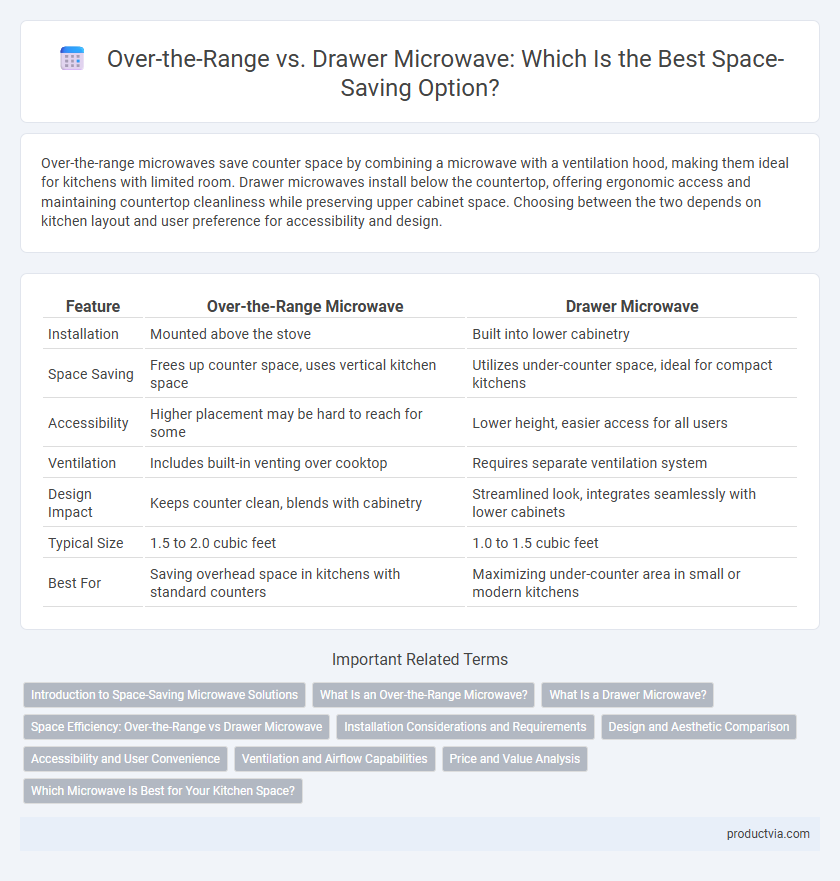Over-the-range microwaves save counter space by combining a microwave with a ventilation hood, making them ideal for kitchens with limited room. Drawer microwaves install below the countertop, offering ergonomic access and maintaining countertop cleanliness while preserving upper cabinet space. Choosing between the two depends on kitchen layout and user preference for accessibility and design.
Table of Comparison
| Feature | Over-the-Range Microwave | Drawer Microwave |
|---|---|---|
| Installation | Mounted above the stove | Built into lower cabinetry |
| Space Saving | Frees up counter space, uses vertical kitchen space | Utilizes under-counter space, ideal for compact kitchens |
| Accessibility | Higher placement may be hard to reach for some | Lower height, easier access for all users |
| Ventilation | Includes built-in venting over cooktop | Requires separate ventilation system |
| Design Impact | Keeps counter clean, blends with cabinetry | Streamlined look, integrates seamlessly with lower cabinets |
| Typical Size | 1.5 to 2.0 cubic feet | 1.0 to 1.5 cubic feet |
| Best For | Saving overhead space in kitchens with standard counters | Maximizing under-counter area in small or modern kitchens |
Introduction to Space-Saving Microwave Solutions
Over-the-range microwaves maximize counter space by combining ventilation and cooking functions in one unit, ideal for kitchens with limited surface area. Drawer microwaves, installed below the countertop, save upper cabinet space and offer ergonomic access without disrupting kitchen workflow. Both options enhance kitchen efficiency by optimizing prime cooking and storage areas for streamlined design and functionality.
What Is an Over-the-Range Microwave?
An over-the-range microwave is a space-saving appliance installed above the kitchen stove or cooktop, combining microwave functionality with a built-in range hood for ventilation. This design maximizes counter space by utilizing vertical space and often includes integrated lighting and exhaust fans to help remove smoke, steam, and odors during cooking. Over-the-range microwaves typically range in capacity from 1.5 to 2.0 cubic feet, making them suitable for most household needs while maintaining efficient kitchen ergonomics.
What Is a Drawer Microwave?
A drawer microwave is a space-saving kitchen appliance installed below the countertop or under cabinetry, offering easy access without occupying overhead space. It features a pull-out drawer design that allows users to access the microwave without bending or reaching up, ideal for smaller kitchens or homes with limited counter and wall space. Over-the-range microwaves, by contrast, combine ventilation with cooking functions but require overhead installation, which can overpower compact kitchen designs.
Space Efficiency: Over-the-Range vs Drawer Microwave
Over-the-range microwaves maximize kitchen space by combining ventilation with cooking functions, freeing up countertop area while utilizing existing overhead cabinetry. Drawer microwaves install seamlessly within lower cabinetry, preserving the countertop and overhead space, ideal for kitchens with limited vertical room or where design aesthetics prioritize clean lines. Choosing between the two depends on kitchen layout, with over-the-range models optimizing wall space and drawer microwaves enhancing under-counter storage integration.
Installation Considerations and Requirements
Over-the-range microwaves require mounting above the cooktop with proper ventilation, demanding a sturdy wall or cabinet support and access to existing electrical and exhaust connections. Drawer microwaves install below countertops or in cabinetry, necessitating precise cutouts for seamless integration and often require dedicated electrical outlets and ventilation solutions underneath or behind the drawer. Both options impact kitchen space efficiency differently, with over-the-range models saving counter space but needing robust installation, while drawer microwaves offer ergonomic benefits but involve complex cabinetry modifications.
Design and Aesthetic Comparison
Over-the-range microwaves integrate seamlessly above the stovetop, offering a streamlined design that combines ventilation and cooking functions to save counter space while maintaining a cohesive kitchen aesthetic. Drawer microwaves, installed beneath the countertop, provide a sleek, hidden look that preserves clean lines and modern cabinetry finishes, ideal for minimalist and contemporary kitchens. Both designs optimize space differently: over-the-range units capitalize on vertical kitchen space, whereas drawer microwaves enhance accessibility and maintain an unobstructed countertop for a clutter-free appearance.
Accessibility and User Convenience
Over-the-range microwaves maximize kitchen space by combining ventilation and cooking functions, offering easy accessibility at eye level for quick dish monitoring. Drawer microwaves, installed below the countertop, provide ergonomic convenience by reducing the need to lift heavy dishes, making them ideal for users with mobility challenges. Both options enhance user convenience while optimizing space, but the choice depends on kitchen layout and accessibility preferences.
Ventilation and Airflow Capabilities
Over-the-range microwaves efficiently combine cooking and ventilation by incorporating powerful exhaust fans that vent smoke and odors directly outside or through recirculation filters, optimizing kitchen airflow. Drawer microwaves, installed below the countertop, generally lack built-in ventilation systems, relying on the surrounding cabinetry for airflow, which may limit their effectiveness in removing cooking fumes. For space-saving kitchens with a strong emphasis on superior ventilation, over-the-range models provide a practical solution by integrating both microwave functionality and advanced airflow capabilities.
Price and Value Analysis
Over-the-range microwaves typically offer a cost-effective solution combining ventilation and cooking functions, with prices ranging from $150 to $400, making them suitable for budget-conscious kitchens. Drawer microwaves, priced between $600 and $1,200, provide sleek installation under countertops, saving upper cabinet space while adding a modern aesthetic and ergonomic convenience. Evaluating value involves balancing initial cost against space utilization and accessibility, with over-the-range models being more affordable and drawer microwaves delivering premium design and functionality.
Which Microwave Is Best for Your Kitchen Space?
Over-the-range microwaves maximize vertical kitchen space by combining a microwave and vent hood above the stove, ideal for small kitchens with limited counter space. Drawer microwaves fit seamlessly into lower cabinetry, freeing up countertop and upper wall space while providing ergonomic access, suitable for kitchens with ample base cabinets. Choosing the best microwave depends on your kitchen layout, ventilation needs, and preferred countertop availability.
Over-the-Range Microwave vs Drawer Microwave for space-saving Infographic

 productvia.com
productvia.com